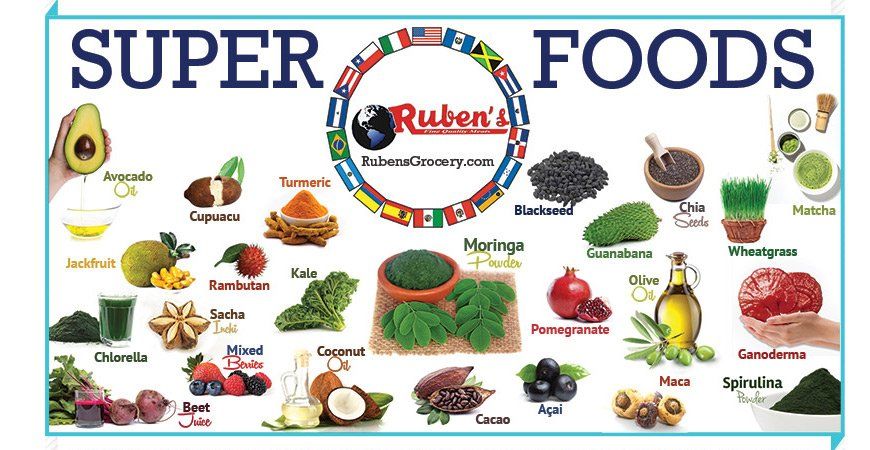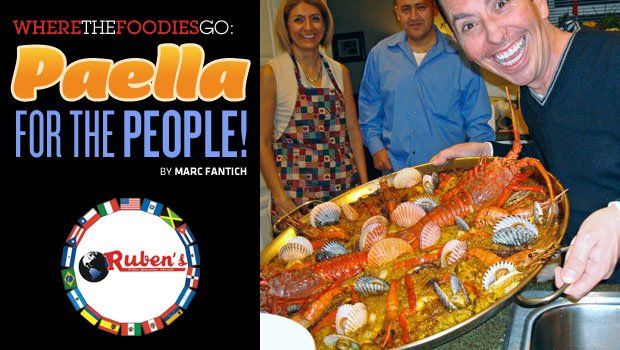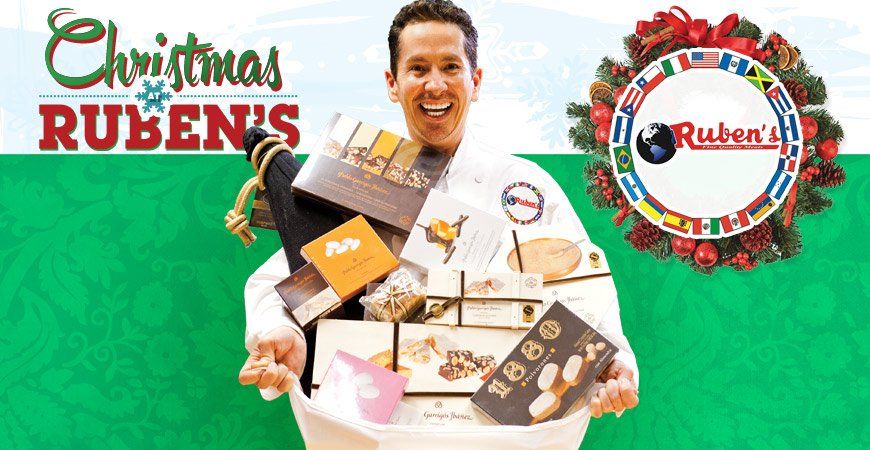News
See all the delicious things that are on their way to Ruben's!

Webster defines MID LIFE CRISIS as a “period of emotional turmoil caused by the realization that one is no longer young.” This used to be a problem that one handled simply by dropping some Benjamins and buying a brand new canary-yellow Corvette. Problem solved, right? Funny, I was stuck at that same crossroad. Turn right and buy a beautiful sports-car? Turn left and get a beautiful new girlfriend? Or go straight ahead and get the new body I desperately needed so I’d live long enough to enjoy both the new car AND the new girl! I found that I wasn’t alone. Every morning my day starts off with a trip to Ruben’s Grocery Store to visit with the staff, grab my day’s snacks and finally, bend Ruben’s ear a little while. Every now and then I run into him and he’ll be using his Nutri-Bullet to whip up this concoction of all sorts of powders and frozen berries. The World of SuperFoods That’s when it hit me. I have never looked at him that way before but he seemed pretty physically fit. Putting two and two together I asked him a few questions and discovered that he works out every day and makes this shake each morning from these magical powders he carries in the store. They each have a name and purpose, but I simply call them “super- food powders.” The Health-Improving Claims The powders he sells are not the normal protein shake powders all the supplement stores carry; these are the real deal: single ingredient, raw, organic, non-GMO superfoods. Powders that help people put their medicine down and start living normal lives again. Ruben’s carries these superfood powders and his brother, Hugo, has started giving these lectures in the store and people are getting healthy. I watched this a few months as I took the powders, mostly skeptical, but I no longer need my blood pressure medication and all my other health-related problems are gone. Coincidence? Nope, too many people are getting better for it to be a coincidence. The Natural Side of Energy As Ruben puts it: “These superfoods are not miracles, they actually don’t heal anything. What they do is feed your body at a molecular level. Most of us are eating a breakfast full of carbs, like cereal or pancakes or tacos. Or sometimes even worse, not eating breakfast at all. When you make a smoothie from the superfoods that contain very low carbs and lots and lots of great proteins based on non-genetically modified plants, your body responds with incredible energy levels. At the same time, your pH changes from acidic to alkaline; the number one factor in cancer is an acidic body. All of this makes your organs, like your kidneys and liver, function at a much higher level and in turn, your body begins to heal whatever ails you.” Eat. Grow. Shine! Today it’s pretty easy to get the body you have always wanted. You just need a plan and I’ll share mine with you. Believe me, if I can do it, so can you. I dropped 220 lbs. Part of that was my ex-wife! She was 120 lbs. You do the math. I take these superfoods powders each morning now, mixed with a glass of tasty yogurt. That’s it. These superfoods powders appear to be doing great things for people. Set aside a few minutes today and invest 10 minutes in getting some free information about these superfoods at Ruben’s. Tell them Marc sent you.

WOW! Christmas season is already here? Where did the year go? The best part about Christmas for me and all my foodie friends is all the things Ruben’s has planned for us. Like importing in all the breads, pastries, candies and once-a-year things that make your house look, feel and smell like Christmas. Everyone looks forward to Ruben’s Panettones from Italy, Argentina, Brazil, and Peru. The Turrones from Spain, Italy, & Argentina. The German Stollens, along with candy from all over the world, including the traditional Mexican Christmas candies Colaciones! The special way that Ruben’s store is transformed into a special holiday cooking and gift destination. On top of all the exciting products that show up for the holidays, here’s what I look forward to the most. Every year Ruben finds that one special thing, that you can’t find anywhere else, like what he does each year with those giant King Crabs. Ruben seeks on something special each year, and knocks it out of the park! I got a sneak peek and by the time this article gets to you, Ruben will already be stocking this specialty item for you and your family…I promise, this will make Christmas at your house unforgettable. Here it comes! About 10 years ago I found BODIN in Spain, the restaurant that holds the Guinness world record for “THE OLDEST RESTAURANT IN THE WORLD.” What makes BODIN in Madrid so special, besides cooking for people since 1725, NEARLY 300 YEARS?!? It’s their roasted suckling pig dish that’s so tender the waiters cut it with a ceramic plate, as well as the “Jabugo Jamon” from these special pigs that only come from that region. Ibérico pigs are a special breed that, oh hell! It’ll take forever to explain. Suffice it to say, these pigs eat a diet from the area they live which is rich in natural resources, in this case, acorns and berries, adding up to the perfect diet for a pig and making them taste better than any pork you will find on this planet or any other planet for that matter : ) Now here’s what Ruben did. For over 100 years the USDA has banned the import of pork from other countries. They said it was impossible to ensure a healthy produce could stand the trip from there to here, so the USDA forbid it, period. End of story. In fact, try to bring over pork chops from Reynosa. I dare you. The Border Patrol will take your chops, AND YOUR CAR, and slap you with a huge fine. So how was Ruben able to pull this off? Who knows! But he did. ONLY Ruben’s, and only for a limited time. He’s not just bringing that pig FRESH, he’s bringing the suckling babies for roasting in your “Ataud” or your kitchen’s oven. The special baby Ibérico pigs, the babies that have only sipped milk from mamma’s breasts, are here now and available for your family to roast and enjoy. “If you don’t know how to prepare this delicacy, ‘Ibérico Pata Negra Lechon,’ Ruben will teach you how to cook it to perfection or you can ask Chef Larry Delgado, of S A L T New American Table, to prepare it for you along with some paired sides,” says Ruben. He always tries to add one more delightful thing to his holiday lineup and he did it again. Suckling pigs, about eight pounds each and pretty simple to roast. They are here now for you to pick up and prepare for an unforgettable evening.

As a pet lover with a long history of living with cats and dogs I have a pretty strong stance on what I’m about to say. All living creatures deserve “REAL” food. That being said, this installment of “Where the Foodies Go” is dedicated to all of our pets. I’d like you to think about something for a second. Have you been brainwashed by the decades of commercials and the billions of dollars of marketing invested on making you think that what you feed your pets is healthy? (You already know where I’m going with this.) First, the truth about pet food off the shelf, and remember, this article honors what Ruben has going on at his unique store. He sells the same “off the shelf” crappy pet food that every grocery store in America sells and this article will kill those sales. But he opened my eyes to an undeniable truth. That being said, the food in the cans and bags we feed our pets is simply awful. Take a moment and read the label’s ingredients. The commercials you see would have you think your dog is getting a sirloin steak straight from the butcher’s stash of his best steaks. Contrary to what the dog food companies show you on TV commercials, your dog doesn’t get sirloin from a healthy cow who spent its life nibbling on fresh tall grass, nor does he get white chicken breast from a hen who spent its life pecking happily around the sunny barnyard. In fact, meat used in pet food comes from what the pet industry calls the Four Ds. The Four Ds stands for meat from livestock that was either Diseased, Disabled, Dying or Dead when it arrived at the slaughter house. It won’t pass the USDA inspection so in the pet food bin it goes. What goes into the pet food bin is deemed unfit for human consumption because of mold, rancidity, or contaminants – yuck! They boil the poison out of it and pulverize it so it can be mixed with other empty calories and either squirted in a can or dried into nasty little kibbles. I have the answer, but first I need to be sure you buy in to this idea. Dogs have been domesticated for about 15,000 years (that’s amazing, isn’t it?) and up until the 1930s, they were NEVER fed “kibble” or “canned” brands from a store. Dogs were fed real meat and vegetables, and a little homemade bread. On this diet they thrived, frequently living into their late teens. How old was your last pet that passed on? 12? 13? These pet food companies are cutting our pets’ lives by 30%, (and we are allowing them). As humans, we constantly hear about our processed food cutting years off our lives and ruining our quality of life with diabetes, obesity and all kinds of ailments caused from a weakened immune system from all the nasty things they put in our processed food. Here’s my question to you. Totally rhetorical. Would you spend an extra 50 cents a day to assure your child lives to the ripe old age of 90 rather that 55? We have that answer for your children already. Feed them an intelligent diet of fresh fruit, vegetables and smart proteins, right? Well, a few weeks ago I got to sit in on a meeting at Ruben’s where this man came in with a recipe that looked like he was making a nutritious stew for a camping trip. It had wonderful ingredients bought right off the shelves at Ruben’s. Blueberries, fresh kale, whole turkeys straight from the butcher’s block and everything else you’d feed your 5-year-old little girl to ensure a smart and balanced diet. But he knew that he did not want to feed him the aforementioned “crappy pet food,” so he researched what he believed to be the smartest diet for his pet and created a homemade blend of the healthiest ingredients. Already being a Ruben’s customer he knew that those ingredients would be found there. His only dilemma now would be to find the equipment to process the food. To his great surprise and relief, he discovered that Ruben’s has been processing very special pet food for about 5 years now. Ruben’s invites you to stop in and see how simple it is to make a couple weeks of truly nutritional food for your pets. You pick the ingredients and Ruben does the rest. It’s simple and we are all doing it. Is it more expensive? Yes it is, about 20 cents more per meal. Do you have 20 cents today? LIKE Ruben’s on Facebook to keep up with all the interesting things he has going on. Those DEADLIEST CATCH crabs are right around the corner, so you want to be on that list!

We all have our “happy place” that we go to feel good. Some retreat to their man cave, others go shoe shopping, some visit mom and dad. Me? I walk the isles at Ruben’s Grocery. Bizarre right? I agree. I have no clue why I do it, but I just do. There are some isles which have things I buy all the time and other isles that I shy away from because I have no idea what lies on those shelves. On this particular visit I found myself on isle #2. Isle #2 is not my favorite, mostly because it’s full of things that I don’t know how to use or just seem too foreign for me to get excited about. But I wanted to learn and there were endless bags of this tea-like product that you drink. Here’s what I found: There is a plant, a shrub really, that grows 50 feet tall in central America. It’s called YERBA MATÉ. What fascinated me was there were so many different bags of this stuff it warranted the question, “Ruben, why on Earth do you carry so many of basically the exact same product?!” Ruben said, “We get as much as we can get our hands on because we want our customers to have great choices. We carry everything from the least expensive to the most expensive. Marc, we don’t have a private brand and we don’t want one. We want to give our customers as many choices as possible and not push any private label products. I love going around the world and bringing our customers as much variety as possible. And it’s not just the Yerba Maté Marc, we do it with everything until we run out of room on the shelves. Breads, cheeses, meats, wine. It’s why you come here. You pass three other “major” grocery stores to get here because of that one fact: Our cool stuff from all over the world! And all those products are here because we listen; we listen to the customer and we do as they ask.” And he’s exactly right. (I also pass a La Michoacana and a Walmart grocery store too). Wait… What was I talking about? Oh yeah. This Yerba Maté business. Yerba Maté has the “strength of coffee, the health benefits of tea, and the euphoria of chocolate,” all in one beverage. Of the six commonly used stimulants in the world: coffee, tea, kola nut, cocoa and guarana, Yerba Maté triumphs as the most balanced, delivering both energy and nutrition. Think of it like Red Bull that your doctor would approve of you drinking. Yerba Maté is made from the naturally caffeinated and nourishing leaves of the South American rainforest holly tree. For centuries, South America’s Aché Guayakí tribe have sipped Yerba Maté from a traditional maté gourd for its rejuvenative effects. These rainforest people find tremendous invigoration, focus, and nourishment in Yerba Maté. This stuff is super good for you, and I’m learning tons about it online as I research it. I’m sort of surprised that it’s not better known here in the United States. The leaves of the Maté tree naturally contain 24 vitamins and minerals, 15 amino acids and a lot of antioxidants, too. In fact, The Pasteur Institute and the Paris Scientific society in 1964 concluded, “it is difficult to find a plant in any area of the world equal to Maté in nutritional value,” and that Yerba Maté contains “practically all of the vitamins necessary to sustain life.” (100% cut and pasted as I’m not nearly that smart). Yerba Maté contains caffeine, theophylline, and theobromine, which are well-known stimulants also found in tea, coffee and chocolate. The caffeine content varies between that of green tea and coffee. Unlike tea, Yerba Maté has a low tannin content so it can be strong like coffee with out becoming extremely bitter. Unlike coffee, Yerba Maté is not oily and acid forming, so it is less likely to cause stomach acid and jitters. Yerba Maté can be drank hot, or cold, served with milk and honey, or even iced with lemon and mint. The combinations are endless. Ruben’s stocks over 50 varieties of Yerba Maté and his customers say his collection is probably the largest in the world. Expect to pay anywhere from $5.99 up to $29. Just like coffee, Yerba Maté has lots of different qualities and procedures. Add a procedure, add a dollar. I’m actually drinking some right now. It’s not bad, and I think it may have helped me in writing, what people will refer to for centuries as, the greatest article ever written about Yerba Maté. You are welcome.

It’s like the Mustang vs. Camaro wars of 1970. Paella faces the same battle. It all depends on who you ask as to which is the right way to prepare it, and I REALLY want to learn how to make one. Don’t you? Before I call my buddy Ruben at Ruben’s Grocery Store to steal his recipe, I’m going to share my research about the history of Paella. Where dishes come from interest me, so guess what, you’re about to learn something. (The fun part is some of my story is made up, like the dates, because dates bore me. The rest, however, excites me!) There are three big stories surrounding who created Paella. WIKI says Paella came from the Moores, the French and the Spaniards. I’m buying into the Spaniard’s story… Probably because Mexico’s story wasn’t on WIKI and the Spaniard’s version of it was the easiest for me to understand. Somewhere back in the 1500s is where the first Paella was traced back. Spanish royalty would have these lavish parties and there were tons of leftovers. The poor people (the people doing the serving) would get to keep these leftovers. They’d split up all the food and take it home to their families. But it was different back then. Villages all shared in these mini feasts and it took huge cooking pans to prepare. They’d add rice and veggies, toss in seasoning and slow cook the Paella until it was ready to be shared by the village. There are 3,000 stories of the origin of the word Paella and here’s the one to memorize: Paella comes from the Spanish word “por ella,” meaning “for her,” and is said to come from the fact that the first Paella was made by a man for his fiancé. Another persuasive story is the word changed a little and was part of some Latin word for BIG OLD PAN… And as Forrest Gump would say, “That’s about all I know about Paella.” Now pack up, kids! We’re taking a field trip to Ruben’s. I want to make a Paella and he’s the guy with all the answers. Marc: Hey Ruben! What exactly do we need to know before diving in headfirst into making a Paella? Ruben: Well, first you need to know that there are two basic schools of thought on Paella. The first is that Paella should always be authentic and should not be changed from the Spanish versions that are cooked in Valencia, Spain. The second school of thought says Paella should be fun and you should be able to do anything you want with it. To the first school of thought I say: BOOOOOOORING! I am loyal to the second school of thought wholeheartedly. Paella should always be fun to both cook and enjoy. Remember there are just five basic ingredients that all Paellas should have (see chart on middle column.) In the 20 years I have been selling Paella ingredients I have NEVER come across two people who have ever agreed on what ingredients they use in their Paella. NEVER! I may be a foodie by trade but I’m a mathematician by education and that small statistic is enough to prove to me that there is no right or wrong recipe for Paella. Marc: Actually, I love dishes that I can tweak here and there. How can it get any better? Ruben: Oh it DOES get better!! It is super easy to make. You know how you love to make pizzas, Marc? Think of Paella as Pizza. Once you get the basics down, like the dough and sauce for pizza, the world of possibilities is endless. Well, the same goes for Paella. Once you get the basics of making the stock and the ratios of stock-to-rice, you can make as many different Paellas as your mind can imagine. First you want to start with the right ingredients: The best rice to use is a short-to-medium grain rice. Each rice has its own unique taste and textures; medium-grain rice is used in Paella because it can absorb a lot more liquid than other kinds of rice, and therefore it will have a much better flavor. The stock should be flavorful and can be made with either chicken, seafood, vegetables or a combination of all three. I start my stock early in the morning and I let it simmer all day long. But there are many shortcuts to consider, as you could start with store-bought stock as well and then enhance it to your liking. Fresh proteins are best and these usually consist of chicken, rabbit, pork, Spanish chorizo, or seafood. Ultimately, the protein you choose can really be anything that suits your fancy. Typical vegetables to consider would be fresh tomatoes, green beans, peas, artichokes, peppers, asparagus, and legumes. They can also be frozen! Again, these are all mere suggestions. And your spices should include things like onions, garlic, herbs, paprika, and of course, the ever present azafrán or saffron. What is saffron or azafrán? Saffron is a wonderfully fragrant spice to use in cooking. It is the stigma of the crocus flower, those little strands that come out of the middle. There is NO measuring of any of these ingredients with the exception of the rice and the stock which is 1 cup rice to 3 cups stock. Everything else is to your fancy, just like salt-and-pepper. There are many videos on YouTube on how to cook Paella, but basically the way it goes is as follows: Brown your proteins, one at a time, in olive oil in your Paella. Add your garlic and onions and cook those until they are translucent and almost caramelized. Now, introduce your vegetables and brown those until they are at least halfway cooked. At this point add your stock and spices and cook until it all becomes somewhat of a soup. Lastly, add rice and stir until completely mixed. Now just simmer until the rice is cooked “al dente,” which means tender, but not mushy. If the stock runs out before the rice is cooked, simply add a little more water. Once the rice is cooked I like to turn up the flame for about five minutes to get a crust on the bottom, also known as socarrat, & that’s it! At Ruben’s you will find every single item you’ll need to make your Paella. From the Paella pan, to the burner, to the rice, spices, and all of the ingredients. And for those that can’t even boil an egg, Ruben’s has Paella kits that allow you to cheat and start your Paella with pre-made broth and spiced rice! All you do is add fresh vegetables and seafood, or any other protein, to make it your own. For additional help simply visit Ruben’s and he will personally walk you through the whole process.

What exactly does “Christmas at Ruben’s” mean? Throw up some lights and hope people spend more money? Well my friends it means, Ol’ Ruben rolls up his sleeves and scours the world for his secret Foodie contacts and gathers all of the greatest holiday sweets he can get his little hands on. Christmas is a time of year that we spend more time with our family and friends and a nearby table with sweets from “Back home” wherever that may be, is always a welcome addition to any gathering. Nothing brings people closer during the holidays that sharing “food memories” with the people we most care about. Christmas always reminds me of my childhood, and memories of my family both here and in heaven. Nothing ties in more to memory than smells and tastes. A smell or taste can bring back a flood of memories and even influence our mood. Because the olfactory bulb is part of the brain’s limbic system, an area so closely associated with memory and feeling, it’s sometimes called the “emotional brain.” Smells and tastes can conjure up memories and powerful responses almost instantaneously. I spoke to Ruben about this and he agreed. “I can’t smell cinnamon without thinking of my grandmother’s kitchen filled with the aroma of atole de arroz” says Ruben. So during this time of year Ruben tries to import things from all over the world that people enjoyed as children at Christmas time in their home countries. This makes Christmas very special at Ruben’s because no matter where you were born, you more than likely will find something from that country to enjoy during Christmas. It also allows one generation to share with younger generations their culture and foods they grew up with. Although you will find many foods at Ruben’s during Christmas, from savory to sweet, the sweets are the ones that are most delectable. Christmas is a time of year when we forget about diets and try to enjoy the all of the wonderful treats that cultures all around the world have specifically invented to celebrate this joyous holiday season. One of those inventions, for example, is Panettone; fruitcake’s Italian cousin. But unlike fruitcake, which was invented out of an abundance of cheap sugar no one new what to do with, Panettone was created from love! According to legend, in the 15th century a young man from Milan fell in love with the daughter of a baker named Toni. With love on his mind he baked a moist, light, fluffy, buttery sweet bread filled with raisins and candied fruit and presented it to the girl’s father in the hopes of winning him (and her) over — and of course, he called it Pan de Toni (Panettone). Well since the 15th century, Italians have moved out of Italy and taken over the kitchens of the entire planet! Hence, Panettone is now baked in almost every corner of the globe. It is now deeply embedded in the cultures of Peru, Argentina, and Brazil. As a matter of fact, the Peruvian Paneton D’Onofrio, in it’s traditional blue box, is one of Ruben’s best sellers. There are very many brands and varieties of Panettone in all of these countries. Ruben brings a little bit of every kind of Panettone; from the simplest commercially produced breads to the most decadent handmade butter and wild cherry incrusted masterpieces. Whatever your budget or pallet wants, you will find it this Christmas at Ruben’s. In fact, Ruben also brings a German version of sorts called Stollen or sometimes called Christstollen. Winter Texans especially enjoy this particular version since many of them come from German backgrounds. Although the big box stores have now caught on to the popularity of these baked goods that Ruben has been importing for over 17 years, Ruben has many treats that are only found in this little grocery store. One of them is arguably the most delicious of all the Panettones: The Amarena Fabbri! This classic Italian bread features Fabbri’s 108-year-old recipe for whole semi-candied Amarena Cherries baked into a buttery, airy delicious cake. And if you are looking for a more traditional Panettone you will find over 8 verities of Maina Panettone, the best Panettone according to the Huffington Post. Rivaling Panettone’s popularity at Ruben’s is the Spanish Turrón. This is my son Eric’s favorite! Turrón, or in Italian Torrone, is a traditional Spanish Christmas confection made from just 4 very simple ingredients: Marcona Almonds, Orange Blossom Honey, Cane Sugar & Egg Whites. But these four simple ingredients in the hands of expert chefs whose families have been making them for centuries become a confection rivaled by none. The Marcona Almonds are far sweeter, moister, and delicately soft, in contrast to the classic sweet variety. These Queens of the Almonds are slow roasted until they are almost weightless. The honey and sugar are then reduced using ancient traditional methods that date back to the 4th century. Finally the egg whites are used to marry the two and encase them in a thin communion wafer. Quite apropos I think. You will find over 100 varieties of Turron from Spain, Italy, and Argentina at Ruben’s starting in mid-November just in time for both Thanksgiving and Christmas.

This Thanksgiving Ruben’s is getting farm raised heritage turkeys! What is a Heritage Turkey? A heritage turkey is one of a variety of strains of domestic turkey which retains historic characteristics that are no longer present in the majority of turkeys raised for consumption since the mid-20th century. Heritage turkeys can be differentiated from other domestic turkeys in that they are biologically capable of being raised in a manner that more closely matches the natural behavior and life cycle of wild turkeys. Heritage turkeys have a relatively long lifespan and a much slower growth rate than turkeys bred for industrial agriculture, and unlike industrially-bred turkeys, can reproduce without artificial insemination. Get your turkeys for Thanksgiving now at Ruben’s Grocery!

Alaskan King Crab is coming to Ruben’s Grocery in October! This is the HUGE crab you see on the TV show The Deadliest Catch on the Discovery Channel. Only 5% of the world’s crab comes from the Bering Sea (where this crab is coming from in Alaska). Only 5% of that 5% makes it to market, whole. The crabs Ruben’s is offering are these extremely rare, whole, Red Alaskan King Crab in perfect form. 5% of 5% is a tiny fraction when you realize you are one of 7 billion people on this planet who has the chance to enjoy one of these 3,000 whole crabs available this season. Yes, 3,000 for the entire world make it out of those ships in perfect form and then are steamed with fresh water. What Ruben’s is offering you here is crab that is completely filled and bursting with flavor. You see, Alaskan Red King Crab can only be harvested during a very short two week season in October. Only the largest and most perfect crabs are flown out around the world fresh for those two weeks. All the rest of the crabs are frozen and sold year round. Yuck! Fresh King Crab is indescribably succulent, sweet and delicious beyond belief. Remember, coming this October, Ruben’s will be offering fresh, never frozen, Red King Crab direct from Dutch Harbor.
